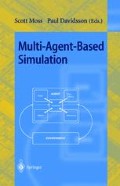Abstract
The simulation study presented in this paper aims to explore the “Simmel effect”, i.e. persistence of social differences under instability of status symbols, as an effect of imitation and distinctiveness. A spatial version of the Simmel effect is implemented. Following higher level agents (imitation) combined with moving away from lower level ones (distinctiveness) are found to produce a segregating effect, with agents belonging to the same hierarchical level sharing the same symbols of status.
Access this chapter
Tax calculation will be finalised at checkout
Purchases are for personal use only
Preview
Unable to display preview. Download preview PDF.
References
Latané, B. (1981) The psychology of social impact. American Psychologist, 36:343–356.
Rockloff, M.J. & Latané, B. (1996) Simulating the social context of human choice. In K. G. Troitzsch, U. Mueller, N. Gilbert, J. Doran (eds) Social Science Microsimulation, Berlin: Springer.
Shoham, Y. & Tenneholtz, M. (1992). Emergent conventions in multiagent systems: Initial experimental results and observations. Proc. of the 3rd Intern. Conf. on KR &R. Cambridge, MA, 225–232.
Walker, A. & Wooldridge, M. (1995). Understanding the emergence of conventions in multi-agent systems, Proc. of the 1st Intern. Conf. on Multi-Agent Systems, MIT Press, 384–389.
Simmel, G. The Fashion (first published in 1895 in Germany).
Cavalli Sforza, L.L. & Feldman, M. (1981) Cultural Transmission and Evolution. A Quantitative Approach. Princeton, N.J: Princeton Univ. Press.
Dawkins, R. (1976) The Selfish Gene. Oxford Univ. Press.
Blackmore, S. (1999) The Meme Machine. Oxford: OUP.
Benvenuto, S. (2000) Dicerie e pettegolezzi. Bologna: Il Mulino.
Author information
Authors and Affiliations
Editor information
Editors and Affiliations
Rights and permissions
Copyright information
© 2000 Springer-Verlag Berlin Heidelberg
About this paper
Cite this paper
Pedone, R., Conte, R. (2000). The Simmel Effect: Imitation and Avoidance in Social Hierarchies. In: Moss, S., Davidsson, P. (eds) Multi-Agent-Based Simulation. MABS 2000. Lecture Notes in Computer Science(), vol 1979. Springer, Berlin, Heidelberg. https://doi.org/10.1007/3-540-44561-7_11
Download citation
DOI: https://doi.org/10.1007/3-540-44561-7_11
Published:
Publisher Name: Springer, Berlin, Heidelberg
Print ISBN: 978-3-540-41522-0
Online ISBN: 978-3-540-44561-6
eBook Packages: Springer Book Archive

